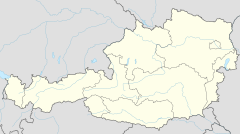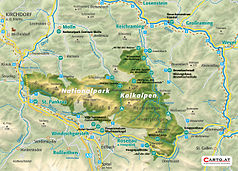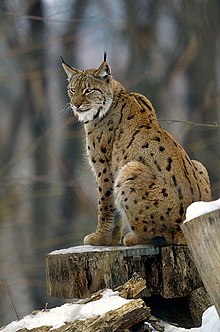Kalkalpen National Park
| Kalkalpen National Park | ||
|---|---|---|
|
|
||
| Location: | Upper Austria , Austria | |
| Surface: | 20,856 ha | |
| Founding: | July 25, 1997 | |
The Kalkalpen National Park is an Austrian national park . It was founded in 1997 and comprises the Sengsengebirge and the Reichraminger Hintergebirge in the Upper Austrian Pre-Alps .
structure

The headquarters of the National Park Society is in Molln , but there are also visitor centers in Reichraming and Windischgarsten that offer information materials, events and exhibitions. Other surrounding places are: Roßleithen , Rosenau am Hengstpaß , Weyer , Großraming and St. Pankraz .
The national park covers an area of 20,856 hectares. 89% of these are designated as natural zones, and eleven percent are conservation zones. 88% of the area is owned by the Austrian Federal Forests , 11% percent in private ownership and 1% percent in municipal ownership.
history
People lived in the national park region as early as the Stone Age . This is shown by stone tools made in Moustérien - Levalloistechnik from this period (65,000–30,000 BC), which were found in the Ramesch cave . Evidence of cave bears , cave lions , wolves and ibexes was also found in this cave . Another seven stone artifacts from Stone Age hunters from between 18,000 and 10,000 BC. Were found in the Nixloch (municipality of Losenstein ).
In the municipality of Windischgarsten several axes and a lance tip from around 1000 BC were found. Found. They indicate a settlement and inspection of the passes.
In this part of Upper Austria, on the borders with Lower Austria and Styria , mainly wood was felled in the core of the limestone foothills for ironmongery industry of Eisenwurzen , and in particular large-scale industry around the city of Steyr - most of the small streams carry too little water for ironworks themselves. The hunting grounds of the Counts Lamberg , in which Franz Ferdinand was the heir to the throne after 1900 , were particularly untouched. In the interwar period, the Reichraming Forest Railway was created, a transport axis that was in operation until the early 1970s. Even after the decline of the iron processing industry (especially during the global economic crisis), a largely intact natural and cultural landscape was preserved.
In 1976 the Sengsengebirge nature reserve was established. Active people (base group, ARGE) and the nature conservation association ÖNB became involved in the 1980s both against the plan of the steel company VÖEST to set up a firing range for tanks in the uninhabited Hintergebirge, and against the subsequent plans of Ennskraftwerke AG to set up two storage lakes in the Hintergebirge. After "occupations" of the Hintergebirge by power plant opponents (at the time of the conflicts over the Hainburger Au ), those interested in the power plant abandoned his plan in April 1985.
As early as 1983 there were first plans for a national park in the Reichraminger Hintergebirge, Upper Austria did not have its own national park at the time. Planning began in 1990 and the corresponding national park law was passed in 1996 in the Upper Austrian state parliament . On July 21, 1997, the National Park was initially established by ordinance on an area of 16,509 hectares, and the Kalkalpen National Park was finally opened on July 25, 1997. International recognition of the Kalkalpen National Park by the IUCN as a Category II protected area took place in the same year.
In 2001 the national park was expanded to 18,400 hectares. In 2003 there was another expansion to 20,856 hectares. Since 2004 the national park has also been a Ramsar area and a Natura 2000 area (European protected area according to both the Habitats Directive and the Birds Directive ). In 2009 there was another change in area in line with the decision of the EC Commission of December 12, 2008.
In 2013, a dispute arose about the intended construction of the first wind power plants in the region around the national park. Energie AG Upper Austria gave up its two wind power projects planned in Steyr and Ennstal in September 2013 because measurements had shown that the wind volume in the Sonnkogel-Schneeberg and Fahrenberg-Mittereck areas was not sufficient for economic viability. With the new wind power master plan 2017 , this became obsolete, since then the entire Alpine region of the state has been a strict exclusion zone for large-scale plants.
In 2017, parts of the Kalkalpen National Park, along with the Rothwald primeval forest and other European forests, were declared UNESCO World Natural Heritage Beech Forests and Old Beech Forests of the Carpathian Mountains and other regions of Europe .
Geography and geology

The highest peak is the Hohe Nock at 1963 meters .
Four fifths of the area is forested, with a mixed forest of spruce , fir and beech trees dominating .
In the national park area there are over 200 km of unobstructed streams and 800 springs.
The main types of rock in the national park are Wetterstein limestone and main dolomite .
To date, over 70 caves have been discovered in the Kalkalpen National Park. The largest cave system in the national park is the Klara Cave , which was discovered in 2004. The deepest cave is the Krestenbergschacht , which drops 412 m from its entrance at 1165 m above sea level. There are also ice caves in the park, these are only accessible to experienced speleologists. The "Ice Chapel" is located in the Sengsengebirge. This cave essentially consists of a 60 m long, 30 m wide and about six meter high hall. In some years a pillar of ice lingers in the middle of the room until autumn. This cave used to be called "Devil's Chapel" by the locals.
Flora and fauna
Around 30 mammals , 80 breeding birds and 1500 butterfly species live in the park . The flora has over 1000 different types of flowering plants , ferns and mosses .
The endangered mammal species are otters , dormice and numerous bat species in the national park. Of brown bear , lynx and beaver , there are individual documents.
The park is the habitat of many bird species that are on the red list in Austria, including: capercaillie , tree falcon , black grouse , whinchat , kingfisher , gray heron , hawk , hazel grouse , stock dove , short-toed eagle , black stork , golden eagle , sparrowhawk , eagle owl , woodcock , peregrine falcon , dippers , white-backed woodpecker , honey buzzard , meadow pipit , nightjar and red-breasted flycatcher .
An endangered reptiles are in the park: Äskulapnatter , mountain lizard , slow worm , grass snake / smooth snake, adder , grass snake and sand lizard .
Of the over 850 identified plant species in the park, 102 are on the Red List of Endangered Plants in Upper Austria.
The oldest known tree in Europe was discovered in 2019. It is a beech tree, the oldest tree rings of which were dated to 1474. The previously oldest known tree in Europe, also a beech and around 20 years younger, is located in the national park.
use
The national park area is under special protection and is easily accessible with hiking trails. The surrounding communities use the area exclusively for soft tourism .
There are 20 alpine pastures in the conservation zone , only a few of which are managed.
Worth mentioning is the Hintergebirgsradweg on the old forest railway line, which opens up the east end of the national park.
See also
literature
- Nature on the rise - the national park in the Upper Austrian Limestone Alps. Landesverlag, ISBN 3-85214-683-6
- Otto Harant, Wolfgang Heitzmann: Reichraminger Hintergebirge. Forgotten mountain home between Ennstal and Sengsengebirge. Verlag Wilhelm Ennsthaler, ISBN 3-85068-171-8
- Gerald Radinger: Hiking experience in the Kalkalpen National Park. The most beautiful tours between Enns and Steyr. Kral Verlag, 2012, ISBN 978-3-99024-066-3
Web links
- www.kalkalpen.at
- The value of nature - an economic assessment of the Kalkalpen National Park
- Kalkalpen National Park, Ennstal region
- Hiking trails to the book Wandererlebnis Kalkalpen
Individual evidence
- ↑ a b c d e f g Official website of the Kalkalpen National Park - key data. Retrieved February 15, 2009 .
- ↑ a b c d e f g h Official website of the Kalkalpen National Park - timetable. Retrieved February 15, 2009 .
- ↑ The Kaiserjäger and his spies. In: Oberösterreichische Nachrichten online (nachrichten.at), November 6, 2014.
- ↑ Wolfgang Heitzmann: But nothing works by itself! - The Reichraminger Hintergebirge is (temporarily) saved. (PDF) In: Natur und Land, Volume 2. Naturschutzbund Österreich, 1985, pp. 41–44 , accessed on January 2, 2015 .
- ↑ Decision alpine biogeographical region (decision 2009/91 / EG) , accessed on July 13, 2011
- ↑ Changes to the European protected area "Kalkalpen National Park" - Reason for the amendment: legal adjustments and changes in area. (No longer available online.) In: portal.wko.at / Environment and Energy / Nature and Biological Diversity: Assessment Nature Conservation. WKO Upper Austria, January 7, 2010, archived from the original on June 8, 2010 ; Retrieved June 2, 2010 . Info: The archive link was inserted automatically and has not yet been checked. Please check the original and archive link according to the instructions and then remove this notice.
- ↑ Headwind for wind turbines. ORF, August 21, 2013, accessed on January 2, 2015 .
- ↑ Energie AG gives up wind turbine project. ORF, September 23, 2013, accessed on January 2, 2015 .
- ↑ orf.at: World Natural Heritage: Austrian beech forests listed . Article dated July 7, 2017, accessed July 8, 2017.
- ↑ Official website of the Kalkalpen - Wald National Park. Retrieved May 19, 2014 .
- ↑ Helmut Steinmassl: The Klarahöhle in the Sengsengebirge (Upper Austria). (PDF) In: Die Höhle / 56th year. Verband Österreichischer Höhlenforscher , 2005, pp. 63–71 , accessed on January 2, 2015 .
- ↑ Josef Weichenberger: Mysterious Underworld - Caves in the Kalkalpen National Park. In: Nature on the rise, Limestone Alps National Park Magazine, Issue 10. Limestone Alps National Park, 1994, pp 26-29 , accessed on January 2, 2015 .
- ↑ Official website of the Kalkalpen National Park - biodiversity, animals and plants. Retrieved May 19, 2014 .
- ↑ a b c Official website of the Kalkalpen National Park - Animals. Retrieved May 19, 2014 .
- ↑ Official website of the Kalkalpen National Park - Plants. Retrieved May 19, 2014 .
- ↑ 546 years: Europe's oldest book in Upper Austria on ORF from August 14, 2019, accessed on August 14, 2019.
- ↑ Official website of the Kalkalpen National Park - Almen & Bergwiesen. Retrieved May 19, 2014 .



